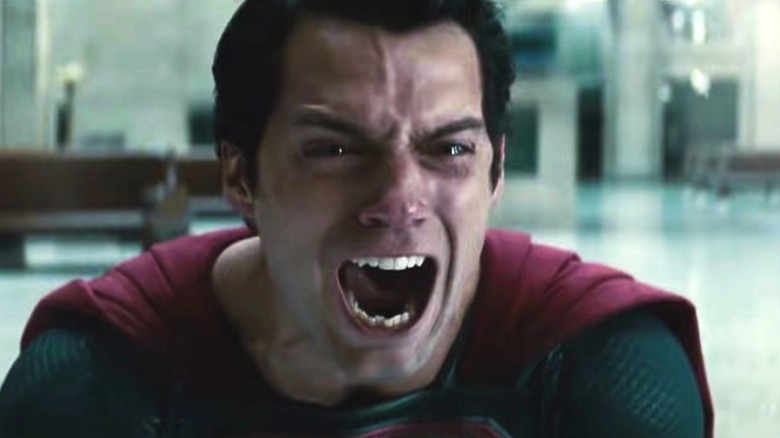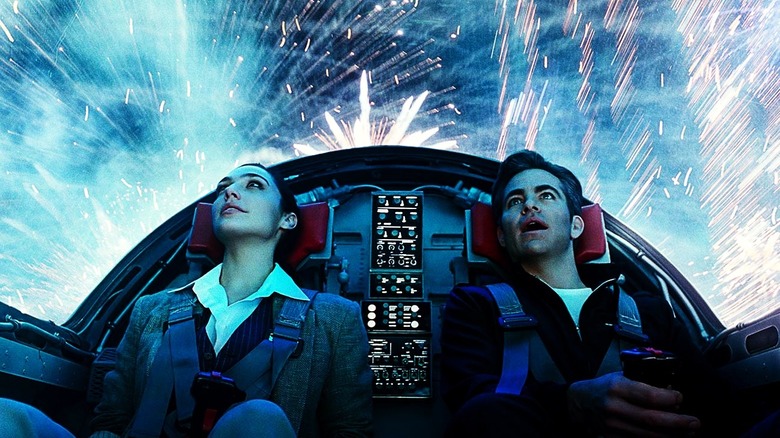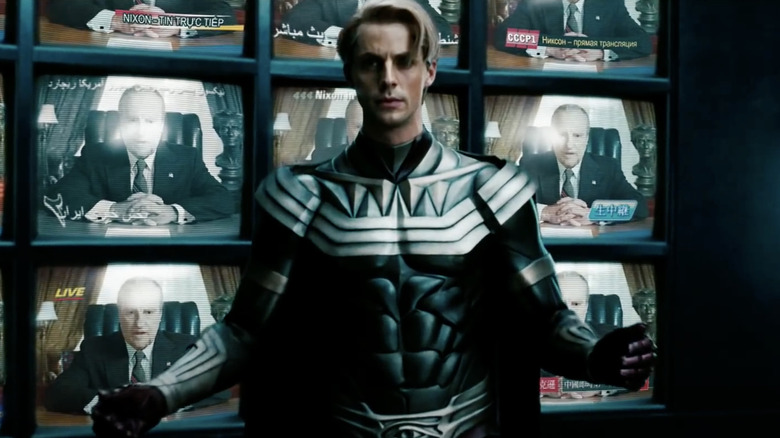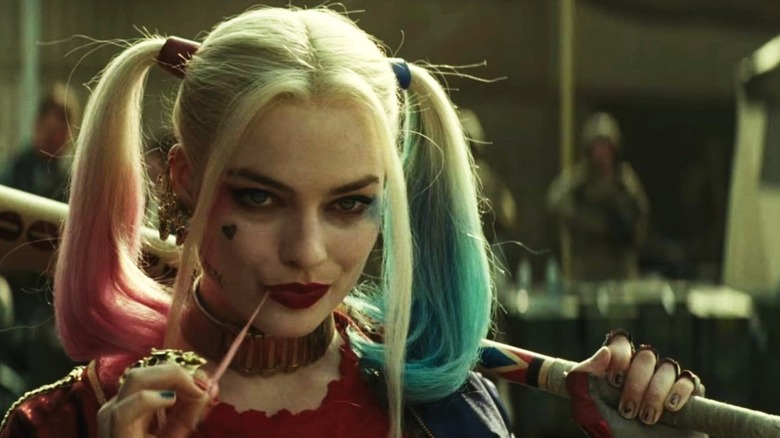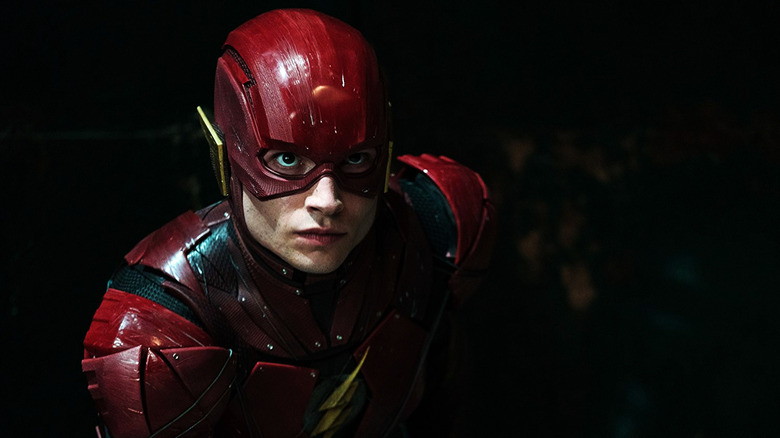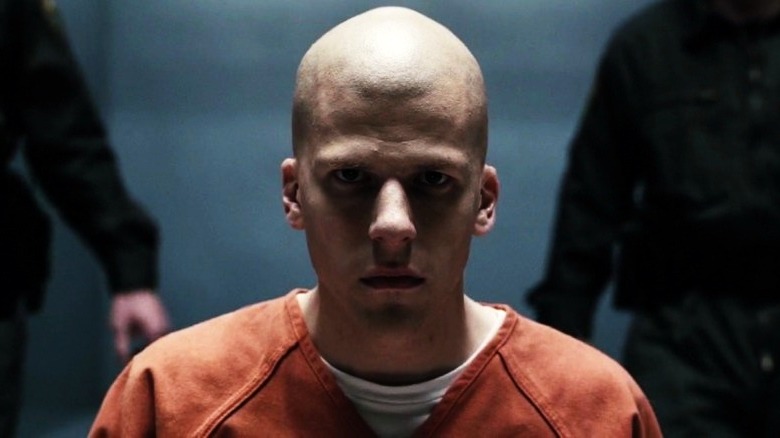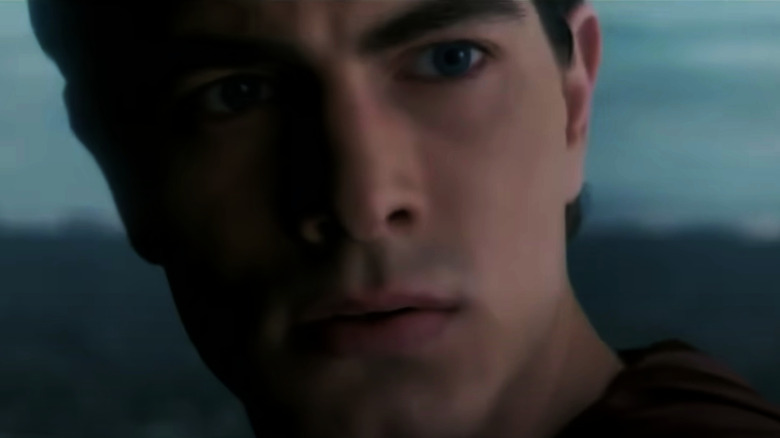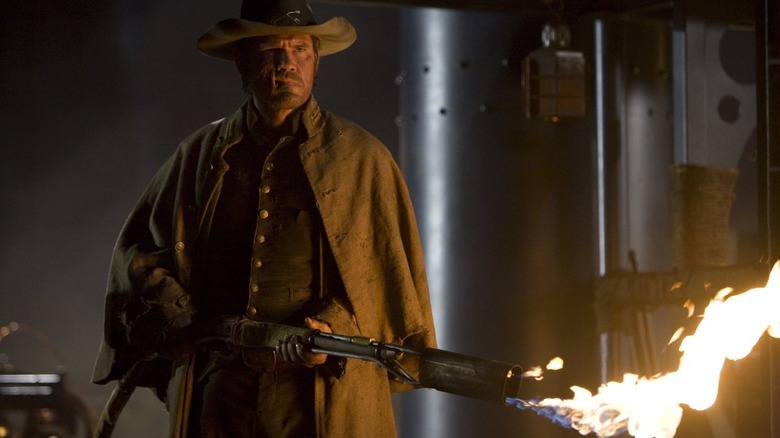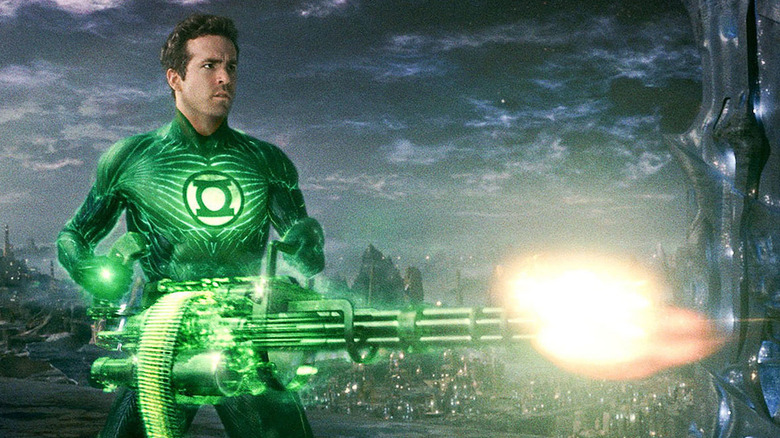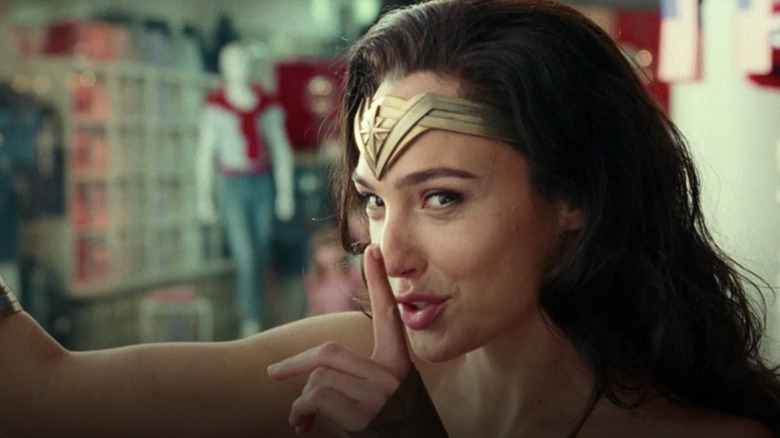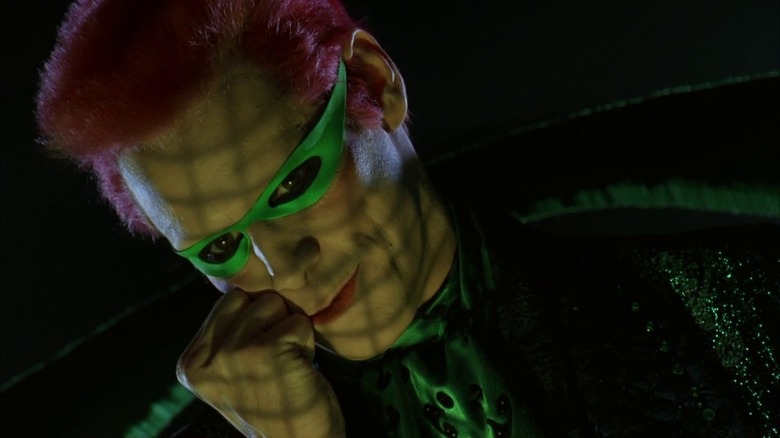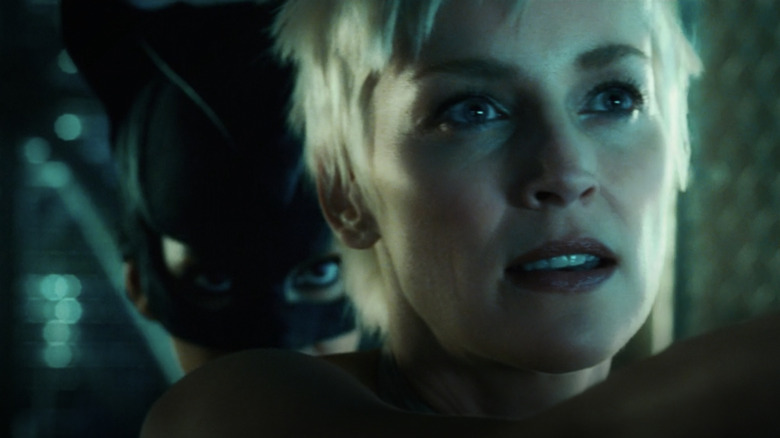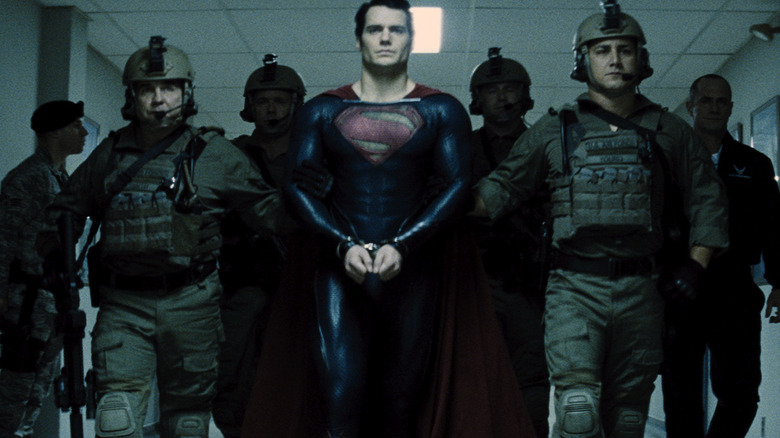DC Movie Scenes That Went Too Far
Movies based on DC Comics properties deliver thrilling sequences you'll never forget and soaring set pieces you must experience on the big screen. However, no strain of cinema is devoid of shortcomings, and this style of adaptation is no exception. Feature-length projects based on the characters of the expansive DC Comics lore have populated movie theaters for decades, and there were bound to be some less-than-exhilarating moments sprinkled throughout those productions. These include moments where certain adaptations went too far, in the process jerking viewers right out of these fictional worlds and back into reality, where they could fully contemplate the ramifications of such egregious scenes.
Some DC movies go too far by treating serious subject matter with frivolity. Others go too far in deviating from their source material. Still others go too far in emulating the tone and style of other motion pictures. Whatever the reason, these moments are a reminder that movies based on comic books offer up all sorts of possibilities beyond just non-stop excitement.
Sexual assault in Wonder Woman 1984
There are countless things audiences could've been expecting to see in "Wonder Woman 1984," none of which was likely a dismissive approach to sexual assault. This shocking development emerged in a scene where Diana Prince, aka Wonder Woman, discovers that her wish on a wishing rock has come true: Steve Trevor has come back to life. Rather than just having Trevor resurrected in his original body, though, the film has Trevor inhabiting the body of a total stranger.
With Trevor back from the dead, he and Prince proceed to have sex. What should be a passionate romantic reunion takes on all kinds of icky tones given that it involves a sexual partner who cannot and did not consent to be involved in this scenario. "Wonder Woman 1984" never addresses these disturbing implications and simply plows ahead on its story about wishes getting more and more out of control. Understandably, this storytelling detour inspired an outcry when "Wonder Woman 1984" was released and tragically reflected how even modern blockbusters can fall prey to problematic tropes that trivialize sexual assault. Of all the things people wanted to see in a "Wonder Woman" sequel, surely this wasn't on anyone's list.
If you or anyone you know has been a victim of sexual assault, help is available. Visit the Rape, Abuse & Incest National Network website or contact RAINN's National Helpline at 1-800-656-HOPE (4673).
Coding Ozymandias as gay in Watchmen
In Alan Moore's original "Watchmen" graphic novel, the character of Rorschach comments in his journal on fellow hero Ozymandias: "Possibly homosexual? Must remember to investigate further." This comment, along with other small details from the graphic novel, has led to widespread interpretations of Ozymandias being queer. Director Zack Snyder ended up also hinting at this orientation during his "Watchmen" film adaptation, though his indicators of such a character trait left a lot to be desired.
For starters, Ozymanidas's superhero costume is distinctly different from the other characters in the movie, with the textures and accentuated nipples on the outfit evoking the superhero costumes in the Joel Schumacher "Batman" movies, whose costumes are generally considered to take cues from queer aesthetics. More egregious, though, is a moment when audiences glimpse Ozymandias's computer and see a file labeled "BOYS". This detail, implying that "Watchmen's" central villain is engaging in pedophilia, continues a troubling pop culture trend of connecting this hideous act with homosexuality. The fact that Snyder's previous movie, "300," also had troubling details that coded characters as villains solely based on them exhibiting queer behavior made it hard to swallow these additions in "Watchmen" meant to codify Ozymanidas as nefarious. Though the concept of Adrian Veidt being queer is not new, the "Watchmen" movie's attempt to depict this notion was unimaginatively distasteful.
Harley Quinn's ending in Suicide Squad
When the original "Suicide Squad" film comes to a close, Harley Quinn is returned to her prison cell, only for the Joker and his goons to suddenly show up and break her out of prison. As alarm bells ring, Joker embraces Quinn and remarks to her that it's time for the duo to go home. This "romantic" reunion is an odd way to end an ensemble effort like "Suicide Squad," since it narrows the focus exclusively to Quinn, but it also goes too far in sugarcoating the duo's toxic relationship.
Alterations to "Suicide Squad" during reshoots and post-production ended up cutting a subplot involving Quinn abandoning and even beating up Joker in favor of teaming up with her new comrades. This development was eschewed in favor of an ending that leaves no room for moral ambiguity, nor any cognizance of just how abusive the Joker's behavior has been. It's an ending that's tidy but doesn't fit either the characters or their relationship, closing the movie out on a note that goes too far and leaves a bad taste in your mouth.
The Flash stumbling in Justice League
In the middle of a "Justice League" fight scene pitting the titular superhero team against Steppenwolf and his Parademon forces, a gag occurs that will jolt most viewers right out of the movie. While running at super-speed, the Flash crashes into Wonder Woman, causing the two of them to fall onto the ground. When the dust settles, it's revealed that Flash hasn't just fallen on top of Wonder Woman, but his face is directly on her breasts. Immediately upon realizing this, The Flash zips up and away from his Justice League teammate and looks around nervously before zooming off to resume his heroic actions.
This strange joke goes too far on countless levels, including the way it disrupts the flow of the fight scene for an extended gag that isn't funny enough to justify its length. It especially goes too far, however, in reducing the lone woman on the Justice League team to just her breasts for the sake of slapstick. The moment is emblematic of how little Wonder Woman got to do in this cut of the movie, and as a cherry on top, "Justice League" reshoots director Joss Whedon did the same gag in "Avengers: Age of Ultron." It's unclear why a joke that went too far the first time it was used in a superhero movie had to be regurgitated here.
Lex Luthor's backstory in Batman v. Superman
There's a lot going on in the third act of "Batman v. Superman: Dawn of Justice," including the introduction of Doomsday and the debut of Wonder Woman's superhero identity. But an equally important, if not as immediately noticeable, development is that we finally get insight into why Lex Luthor hates Superman and the very concept of superheroes so much. When the Kryptonian confronts Luthor over kidnapping Martha Kent, Luthor begins to ramble about his motivations, which include him commenting that "No man in the sky intervened when I was a boy to deliver me from Daddy's fist and abominations!"
This line indicates that Luthor suffered from child abuse, and that these traumatic experiences fuel his hatred for people like Superman. The lingering aftereffects of an abusive childhood is a weighty issue to suddenly bring up in the third act of a PG-13 superhero movie. There's nothing inherently wrong with superhero films dealing in heavier subject matter, but the problem is that at this point in the movie, "Dawn of Justice" is about to shift its focus almost entirely to comic book characters fighting each other, and then fighting a big CGI monster. There's no time to give this revelation the weight and breathing room it requires. Abruptly bringing it into the fold as a way to explain why Luthor is so evil goes way too far and further derails "Dawn of Justice's" already complicated conclusion.
If you or someone you know may be the victim of child abuse, please contact the Childhelp National Child Abuse Hotline at 1-800-4-A-Child (1-800-422-4453) or contact their live chat services.
Superman stalking in Superman Returns
After being away from Earth for years, it's understandable that Clark Kent, aka Superman, would want to check up on his loved ones and see what they're up to. Rather than do the normal routine of calling up people you care about or perhaps checking out their social media pages, however, Superman opts to go to Lois Lane's house, float in the air a short distance away from it, and use his X-ray vision to see inside the domicile. Now he can observe Lane and her newborn kid and what their day-to-day routine is like. These poor mortal human beings are totally oblivious to the superpowered stalking going on.
This goes too far in countless respects, but it's especially rough in that this was clearly thought of as a perfect way to explore Superman's sorrow over being away from his loved ones for so long. Surely there could've been more effective ways of conveying this attitude than via some light stalking? It makes Superman (who's too powerful to be held accountable by anyone) seem creepy rather than inspiring or fun. This scene proved so notorious that 15 years later, an episode of the Arrowverse show "Superman & Lois" (about an older version of the couple and their teenage sons) devoted an entire subplot to the idea that using superpowers to listen in on your family is weird — Lois explicitly mentions that Superman had spied on her years before, and almost lost her as a result.
Jonah Hex's supernatural powers
The opening of "Jonah Hex" establishes a bog-standard origin story for the titular superhero (played by Josh Brolin), as audiences see his adversary, Quentin Turnbull (John Malkovich), brand Hex's face and then burn down his house with his wife and daughter inside. Hex is left for dead but is revived by a group of Native Americans — the sequence depicting this resurrection also establishes that Hex now has the ability to temporarily resurrect dead people himself, an ability he didn't have in the comics. In the comics, in fact, he doesn't have any superhuman powers at all.
There's nothing wrong with making tweaks or even generous alterations to long-established fictional comic book characters when it comes to translating them to the big screen. This scene, however, goes too far in deviating from the source material by bestowing Hex with supernatural gifts. Westerns are all about realism and action scenes happening between tangible human beings, but going this more stylized route and giving Hex superpowers directly challenges that. And what does countering this inherent part of both the established Jonah Hex character and the Western genre as a whole accomplish? Pretty much nothing, with the film only making sporadic use of Hex's newfound abilities.
Green Lantern's parking lot skirmish
Early in "Green Lantern," Hal Jordan gets a chance to try out his new ring during a skirmish with some of his former co-workers. As a test pilot for Ferris Airways, Jordan's reckless actions cost the company money, which resulted in people getting laid off. Shortly after he acquires the Green Lantern ring, a few of these unfortunates corner Jordan in a parking lot. After beating him up for a while, they start to walk away, but Jordan calls them back, and his ring produces a massive green fist that sends his adversaries spiraling through the air. What had been an embarrassing bit of comeuppance a moment before is now an early example of Jordan discovering how useful the Green Lantern ring can be in combat.
This sequence is puzzling on several levels, including how it's lit and filmed, but it's especially strange in its power dynamics. Agitated working-class people are framed as evil, while a figure like Jordan, who had power and influence even before he got an alien ring, is the plucky underdog. And it only gets more puzzling when the physical abuse of these working-class individuals (one of whom gets thrown so hard he shatters a brick wall) is played off as a cheer-worthy moment. Some superhero movies portray the rich and powerful as villains, but in "Green Lantern," it's the poor people who need to be wiped out with a big green fist.
Racial stereotypes in Wonder Woman 1984
The quest by Maxwell Lord (Pedro Pascal) to utilize the wishing rock to the best of its abilities in "Wonder Woman 1984" eventually takes him across the world to Egypt to visit Emir Said Bin Abydos (Amr Waked). The presence of this oil baron character kicks off a deluge of astonishingly tone-deaf stereotypes about people hailing from the Middle East and North Africa. Every scene set in Egypt in "Wonder Woman 1984," even ones where Abydos is off-screen, are jaw-dropping in how much they cross the line in delivering regressive portrayals of MENA individuals. Naturally, such depictions were bound to generate controversy as well as thoughtful essays breaking down the intricate ways these scenes were so off-the-mark.
One of the more insightful examples of these breakdowns came in a piece for Slate, where writer Roxana Hadidi broke down some of the worst cultural misconceptions in "Wonder Woman 1984." These include characters referring to Abydos as "your highness," despite Egypt being a democracy in the 1980s, as well as the ways in which Abydos' costume resembles traditional attire from Saudi Arabia or the United Arab Emirates rather than Egypt. Such inaccuracies feed into dehumanizing stereotypes of MENA individuals and signify that "Wonder Woman 1984," a film that seeks to celebrate the cinema of the 1980s, was unable to escape the racial caricatures that were so rampant in that era.
Riddler's taunts in Batman Forever
Jim Carrey's over-the-top performance as Edward Nygma, aka the Riddler, in "Batman Forever" is a problem throughout the film's entire runtime. You can't fault him for lack of energy, but the whole thing feels too much like Carrey mugging rather than crafting a distinctive character. It also comes off too much like the producers wanting to recapture the magic of combining a huge movie star with an equally famous comic book baddie à la Jack Nicholson's Joker in the 1989 "Batman" movie. It's just a messy performance all the way down, especially when it comes to the feature's climax.
Here, the Riddler has tied up important people in Batman's life, including his sidekick, Robin. As he holds the young ward captive, Riddler taunts Batman by noting "This acrobat-turned-orphan likes Saturday morning cartoons and dreams one day of being bare naked with a girl!" Past "Batman" films like "Batman Returns" used overt displays or references to sexuality to reinforce a gothic noir vibe, or the lewd behavior of men in power. Riddler mocking Robin's implied virginity merely reinforces the extent to which Carrey's performance has gone beyond its breaking point.
The final fight scene in Catwoman
Every major superhero movie inevitably ends with a big confrontation between the hero and villain. In the case of 2004's "Catwoman," the battle between the titular superhero (portrayed by Halle Berry) and evil cosmetics executive Laurel Hedare (Sharon Stone), is a good example of a superhero movie scene going too far not because of offensive material or thematically inconsistent storytelling, but simply by trying too hard.
All throughout "Catwoman," scenes like the infamous flirty basketball game have made it clear this is a production that would love to be seen as a campy good time. The finale, with Berry grimly intoning lines like "It's overtime!" as a big action movie quip, is no different. Unfortunately, "Catwoman" lacks the creative unpredictability that defines great pieces of camp, such as "The Rocky Horror Picture Show" or the works of John Waters. Those projects work because they following a unique creative vision, not a rigid blueprint for what campy cinema should look like. The latter approach plagues "Catwoman's" final showdown — despite an abundance of cheesy lines and the participation of camp queen Sharon Stone, the film's finale is dominated by predictable action beats. Leaning so hard into those elements delivers a climax that's uncomfortably lackluster rather than deliriously campy.
The snapping of Zod's neck in Man of Steel
It's been written about ad nauseum, from comics writers talking about how appalled they were by this moment to extensive defenses from people who found it effective. However, even with this avalanche of discourse, the snapping of Zod's neck at the end of "Man of Steel" still stands out as a premiere example of a DC Comics movie going too far. At the end of the film that launched the ill-fated Snyderverse, Superman is forced to choose between killing Zod or allowing him to kill innocent civilians. Our hero opts for the former, snapping Zod's neck and then proceeding to wail in misery over murdering the only other surviving member of his species.
The concept behind this moment isn't an inherently bad one, especially for a Superman origin story. However, in execution, it doesn't have much impact coming off a lengthy sequence of endless fist-fighting between the two Kryptonians. How can a neck snap compare to seeing buildings crumble and aliens create craters? What's more, neither the rest of "Man of Steel" nor subsequent DC films pause for any length of time to absorb the full consequences of Superman's actions. This multitude of problems ensures that the snapping of Zod's neck emerges as one of the most notable instances of a DC Comics movie going too far.
